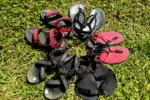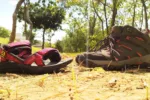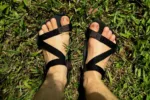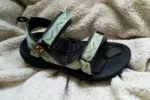How long do hiking sandals last? (7 Super-Durable Models)
This post may contain affiliate links. This means that we may receive a small commission from purchases through those links. Read more in our affiliate disclosure.
Let’s discuss an essential yet often overlooked aspect of hiking—having durable footwear. We’re putting hiking sandals under the microscope, answering the crucial question: “How long do they actually last?”
Hiking sandals generally have an average lifespan of 600-1000 miles (that is, 1000 to 1600 km), which is comparable to lightweight hiking boots. Durability varies across brands and styles. Source, Chaco, and Keen are often praised for the longevity of their products, while brands like Teva, Xero and Luna present a mixed bag, especially for minimalist designs. Observing for wear signs like a smoothed-out sole, frayed straps, or less effective fasteners helps determine when it’s time for a replacement. Some damages, such as a disconnected strap from the sole, can be repaired, but this might affect the sandals’ comfort. Caution is advised against cheap knock-offs and no-name brands, which may lack quality control and customer service.
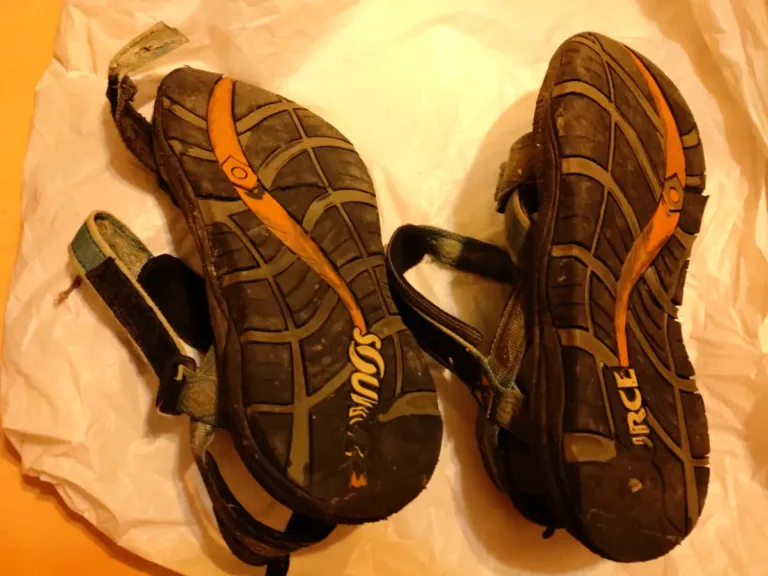
Expected Lifespan of Hiking Sandals
Let’s start with the bottom line—hiking sandals, like our cherished trails, have their seasons. With constant use, you can typically expect these sturdy companions to last anywhere from 600 to 1000 miles / 1000 to 1600 km. That’s similar to the lifespan of lightweight hiking boots. Pretty decent, right?
But it’s not just about the miles, it’s also about the conditions. Sandals that get to bask in the sun on dry, even trails will age slower than those battling through water, rocky terrains, or even city pavements—our concrete jungles are pretty abrasive, you know. And of course, quality matters. That pair you grabbed from the discount rack might not see as many sunsets as the high-end one.
How Do I Know if My Hiking Sandals Are Worn Out?
First and foremost, take a good look at the soles. If they’re worn out or smooth, or if inner layers are showing, it’s a clear sign they’re past their prime. You’ll need all the traction you can get on those slippery stream crossings, and a smooth sole just won’t cut it.
The ones in the picture above, for example, have lost all their profile in the spots where weight is applied, making them less then ideal for slippery or wet terrain.
Then, inspect the straps. If they’re frayed or cut—beware! They might just snap when you least expect it, leaving you stranded. Plus, worn straps can cause blisters—and trust me, that’s a one-way ticket to ruin your day on the trail.
Another way for a sandal to break—as illustrated in the above picture of my worn-out sandals—is for the straps to separate from the sole. This is the most annoying one, as you can’t quite see it coming—but if you notice a strap lengthening for no reason, that’s probably your warning sign.
In either case, don’t be like me and take your oldest sandals on a long holiday trip—they might not make it.
Can You Repair Hiking Sandals?
Ah, the age-old question—repair or replace? Well, the answer isn’t as simple as the question.
Let’s be honest—hiking sandals aren’t immortal. The soles will wear out, the straps might rip, and they might even separate from the sole. Some of these ailments are easier to mend than others.
If your soles are worn out, it’s best to bid adieu to your beloved sandals. A worn-out sole means your sandals have walked their walk. They’ve seen their share of sunsets and streams, and it’s time for a new pair to take the reins.
Ripped straps, on the other hand, could be mended. But still, a patch job is just that—a patch. It won’t restore the sandal to its former glory, and the comfort is often not the same. If the mend rubs against your foot, you might quickly develop sore spots.
If the straps have disconnected from the soles, a shoe-maker might be able to sew them back together. But, in my experience, they usually don’t get the angle perfectly right, which makes the sandals less comfortable—and at this point, it’s only a matter of time until they fall apart somewhere else.
How Durable Are Different Brands of Hiking Sandals?
The following information is gathered from personal experience of me and my friends and hiking buddies, and cross-checked by scouring hundreds of online comments. However, it’s difficult to give a definitve number for how many miles each hiking sandal can be expected to last, as for most people it’s rather hard to estimate how far you’ve really walked in a pair of sandals before they fell apart. Also, manufacturing processes may have changed over time, and the longevity of currently produced sandals won’t be apparent until they reach their expiry date.
That being said, let’s talk about some popular brands.
Teva
Teva sandals, particularly those from the ‘Original Universal‘ and ‘Hurricane‘ lines, often receive high praise for their durability. They’re known for standing their ground against heavy use, with many users reporting them to last for several years. However, not all models are created equal—while the ‘Mush’ flip flop scores high on comfort, it might not be as enduring as its counterparts.
Also, we’ve heard occasional complaints that newer versions of even the more durable models don’t hold up quite as well as they used to.
Chaco
Chaco is another heavyweight when it comes to durability. The robust and durable design of their popular models like the ‘Z/Cloud‘ series makes them a reliable choice for intensive outdoor activities. And if your beloved Chacos do suffer a mishap, their repair service might just breathe new life into them!
Source
Source sandals generally have a reputation for being long-lasting. The ‘Classic’ and ‘Gobi’ models receive particularly good feedback for their durability. Plus, their warranty against manufacturing and material defects provides an added layer of reassurance: As long as the greed dot on the sole is still visible, you can get a replacement. I’ve tried it, it’s very unproblematic!
For the Source Gobi I am actually kind of confident that I can give a number—mine tend to start falling apart after one year of constant use (i.e., as my sole pair of footwear for both everyday use and hikes), and after some repairs finally become entirely useless after 1.5 years. That’s at least 800 miles.
Xero
Xero, known for their minimalist designs like the ‘Z-Trail‘, presents a more mixed bag when it comes to durability. Some users vouch for their longevity, while others report quicker wear and tear—this could be a trade-off for their minimalist design.
With my own Xero sandals, I observe that they are well made, hold up excellently, and I have yet to break one. On the other hand, I’m not quite at the point yet that I could wear Xeros on rocky mountain expeditions, so I personally don’t have enough data to really compare them to other brands.
Luna
Luna, popular for its barefoot-style sandals, also generally receives positive feedback on durability. However, as with all sandals, the longevity can depend on how well they’re used and cared for. Again, due to being more minimalist, there is less “buffer” for how much wear and tear they can take before they break down.
Shamma
Shamma Sandals, another entry in the minimalist, barefoot-style category, are often lauded for their durability and ability to withstand regular use. Many of their models have somewhat thicker, but still zero-drop soles, which helps them last longer. Plus, they’re actually made for running, so they gotta withstand a lot of stress!
I’ve used mine for 7 months straight now, and they show no signs of slowing down, so that’s a good sign!
Keen
Keen, especially the ‘Newport’ series, is a name often associated with durability. Designed for rugged outdoor use, many users testify to their long-lasting nature.
What hiking sandals are not so durable?
Generally, extremely cheap or no-name brands might not have the same longevity as the established ones. These products often lack quality control, reliable customer service, and the warranties you’d typically associate with reputable brands.
Additionally, while many are fans of the minimalist or ‘barefoot’ style sandals, such as those from Xero Shoes or Bedrock Sandals, these models might not be as durable as more robust hiking sandals. The minimalist design, although appealing, can lead to quicker wear and tear under intense or heavy use.

